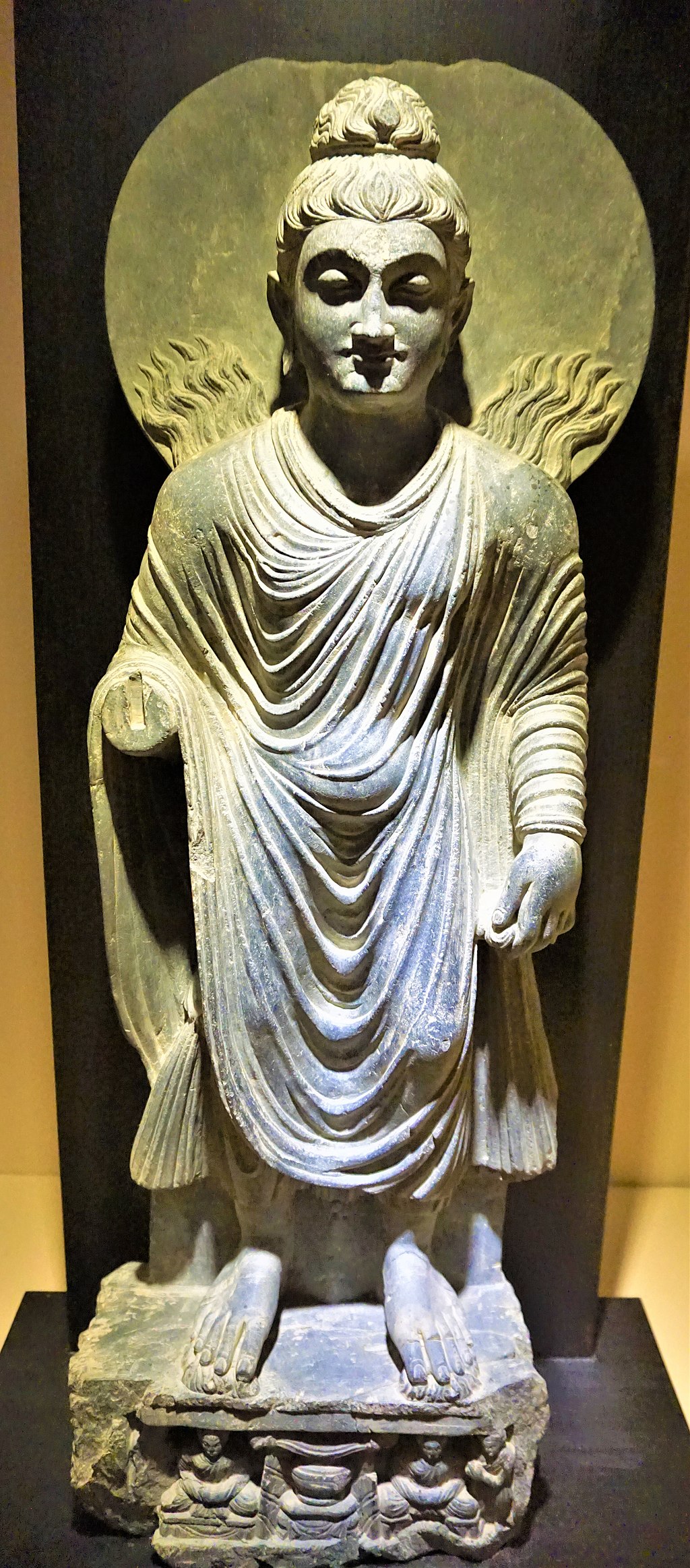
“Buddha performing Twin Miracles at Sravasti” depicts Buddha with a halo behind his head, long earlobes, and wavy hair. The Buddha is depicted performing the Twin Miracle, also called the Miracle at Sravasti. It is one of the Miracles of Gautama Buddha and was enacted seven years after his enlightenment, in the location of Sravasti.
The Buddha was an ascetic and sage, on whose teachings Buddhism was founded. He lived and taught mostly in the eastern part of ancient India sometime between the sixth and fourth centuries BCE.
The miracle occurred during a contest with heretics, who were attempting to perform their miracles. The Buddha perform the miracle that no one else could achieve. He emitted flames from the upper part of his body and a stream of water from the lower, and then again in reverse. Flames of fire and streams of water also proceeded alternatively from the right side of his body and the left. This statue depicts the fire emitting from behind his shoulders, and water is flowing from his toes.
Greco-Buddhist Art
This statue of the Buddha comes from ancient Gandhara in modern-day Pakistan. Like other Gandharan or Greco-Buddhist art, the sculpture shows influence from Ancient Greek sculptural art. Gandhara had been part of the Greco-Bactrian Kingdom established by Alexander the Great. Gandhāra was an ancient Indic kingdom in the northwestern region of Pakistan, around Peshawar.
Statues of the Buddha were not made until after the 1st century CE. For the first four hundred years after his death, Buddha was represented by symbols alone such as his footprint or an empty throne or Bodhi tree. The statue was made in the 2nd or 3rd century, and although Buddha lived in the 4th century before Christ, this is an early and rare example of Buddha in human form.
The statue was carved in excellent detail and the pose, which was to become one of the several standard ones. On the front of the base, there are much smaller figures. His robes feature the distinctive folds carved in well-rounded ridges and terraces that smooth out at the shoulders. The neckline is in high relief with a plunging, and a semi-circular edge that is echoed as the robe overlap his knees.
Gautama Buddha
Gautama Buddha (c. 563/480 – c. 483/400 BCE) or simply the Buddha was a monk, mendicant, sage, philosopher, teacher, and religious leader on whose teachings Buddhism was founded. He lived and taught mostly in the northeastern part of ancient India sometime between the 6th and 4th centuries BCE.
Gautama taught a Middle Way between sensual indulgence and the severe asceticism. He is believed by Buddhists to be an enlightened teacher who attained full Buddhahood and shared his insights to help sentient beings end rebirth and suffering. Accounts of his life and discourses are believed by Buddhists to have been summarised after his death and memorized by his followers. Various collections of teachings attributed to him were passed down by oral tradition and first committed to writing about 400 years later.
Gautama Buddha
- Other names: Siddhartha Gautama, Siddhattha Gotama, Shakyamuni
- Born: 563 or 480 BCE, Lumbini, Shakya Republic
- Died: 483 or 400 BCE (aged 80), Kushinagar, Malla Republic
- Known for: Founder of Buddhism
Buddha performing Twin Miracles at Sravasti
- Title: Buddha performing Twin Miracles at Sravasti
- Date: 2nd/3rd century
- Material: Grey Schist, a metamorphic rock
- Size: H: 78.5 cm; W: 28 cm; D: 13 cm
- Origins: Gandhara, Pakistan
- Museum: Buddha Tooth Relic Temple and Museum
Highlights of the Buddha Tooth Relic Temple and Museum
- Meditating Buddha Shakyamuni
- Buddha performing Twin Miracles at Sravasti
- Buddha Tooth Relic Temple and Museum
Explore Buddhist Art
- Walking Buddha
- Meditating Buddha Shakyamuni
- Mucalinda Sheltering Buddha
- Buddha Protected by Mucalinda
- Buddha performing Twin Miracles at Sravasti
- Buddha
- Seated Buddha from Gandhara
- Bodhisattva Avalokiteshvara – Guanyin
- Seated Bodhisattva Avalokiteshvara – Guanyin
- Luohan – Yixian Glazed Ceramic Sculpture (British Museum)
- Luohan – Yixian Glazed Ceramic Sculpture (Royal Ontario Museum)
- Luohan – Yixian Glazed Ceramic Sculpture (MET)
- Garuda (British Museum)
- Avalokiteshvara – Guanyin (British Museum)
~~~
“Peace comes from within. Do not seek it without.”
– Buddha
~~~
Photo Credit: 1) JOM
Popular this Week








 Sponsor your Favorite Page
Sponsor your Favorite Page SEARCH Search for: Search Follow UsJoin – The JOM Membership Program
Sponsor a Masterpiece with YOUR NAME CHOICE for $5
Share this:
- Tweet
